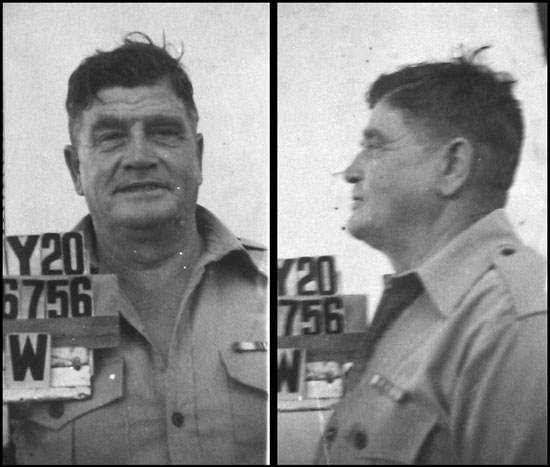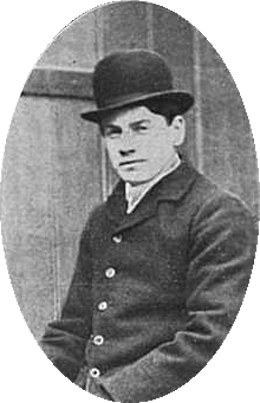Lieutenant William George Eighteen
William George Eighteen was born on 13 December 1889 in Reading, Berkshire, the fifth of eight children of fish merchant (later horse dealer) John Eighteen and his wife Sophia (née Dell). He was educated at Reading Collegiate School. In early 1909 he married Lillian Frances Mary Gardner. At the time of the 1911 Census they were living at 28 Salford Avenue, Reading, with their two children, William working as a horse dealer.
Eighteen left England for South Africa in 1913 or 1914. It seems that by then he had separated from his wife. On 1 September 1914, following the outbreak of war, he enlisted in the Natal Light Horse (regimental number 60). He served with that regiment in German South West Africa until discharged on completion of his service on 27 January 1915.
On 16 January The Reading Standard carried a report on:
Rifleman William Eighteen, of the 'A' Squadron Natal Light Horse, which helped to quell the Boer rebellion. Son of Councillor and Mrs. John Eighteen, of Reading, and formerly a regular rider to hounds in the Garth and South Berks countries, he went to South Africa a year ago and volunteered on the outbreak of war. The Natal Light Horse is the only all-British corps there and has been through the roughest work in the local war zone. Writing on December 1st he said he had been in the field two months and during that time had traversed a large tract of country and had taken part 'in a few lively little scraps.' He has had some narrow escapes; on one occasion his horse was shot under him. In the same letter he said he was in the best of health and in the highest spirits and was expecting to go to a German colony after spending a few days 'in civilisation.'
Eighteen returned to England, arriving on 20 February 1915. He applied for a commission in the cavalry on 22 March but was unsuccessful.
On 10 September 1915 at Aldershot he enlisted in the 1st Reserve Regiment of Cavalry (No. GS/19569). He was posted to the 5th Dragoon Guards, C Squadron, and for a time was acting assistant riding instructor for the regiment at Aldershot. On 22 December he was appointed unpaid lance corporal.
On 1 March 1916 Eighteen applied for a commission in the cavalry, artillery or Army Service Corps, with a preference for the cavalry or yeomanry. He was posted to No.2 Cavalry Cadet Squadron at Kildare on 18 May. On 6 September 1916 he was commissioned as a 2nd lieutenant and posted to the 10th Reserve Regiment of Cavalry at the Curragh.
The following year he embarked for France, where he was attached to the 2nd North Irish Horse Regiment, joining it in the field at Boeschepe on 6 April. According to the regimental diary he was posted to B Squadron, but Army List records have him attached to the 6th (Inniskilling) Dragoons Service Squadron – A Squadron.
The regimental diary of 29 June noted that a 'conducting party' of 128 other ranks under 2nd Lieutenants Pallant and Eighteen travelled to Calais to collect new horses for the regiment.
In September 1917 the 2nd NIH Regiment was disbanded and most of its officers and men were transferred to the 9th (Service) Battalion, Royal Irish Fusiliers, an infantry regiment. Eighteen was posted to the battalion on 23 September but did not join it. He had left for England two days earlier, following treatment for 'otitis media' (middle ear infection) in the No.2 General Hospital at Le Havre.
Admitted to Reading War Hospital on 10 October, a Medical Board later that month found him 'fit for light duty', and he was posted to the 2nd Reserve Cavalry Regiment at Newbridge. On 6 March 1918 he was promoted to lieutenant. Through 1918 he largely remained in Medical Category C1 – fit for home duty – but on 29 November 1918 a Medical Board found him permanently unfit for further military service. He relinquished his commission due to ill-health on 12 December.
On 27 April 1922 Eighteen emigrated to Australia. When the Second World War began he was working as a contractor in Kalgoorlie, Western Australia. In January 1942 he enlisted in the Australian Army, joining the 5th Garrison Battalion. He was discharged on 21 March 1944 and joined the Volunteer Defence Corps (the Australian version of Britain's Home Guard), serving in Perth until he was discharged on 23 December 1944.
He died in Perth on 5 August 1969 and was buried in Karrakatta Cemetery.

The first image is from The Reading Standard, 16 January 1915. The second image is from Eighteen's Australian Army service file, courtesy of the National Archives of Australia.
This page last updated 10 October 2023.

